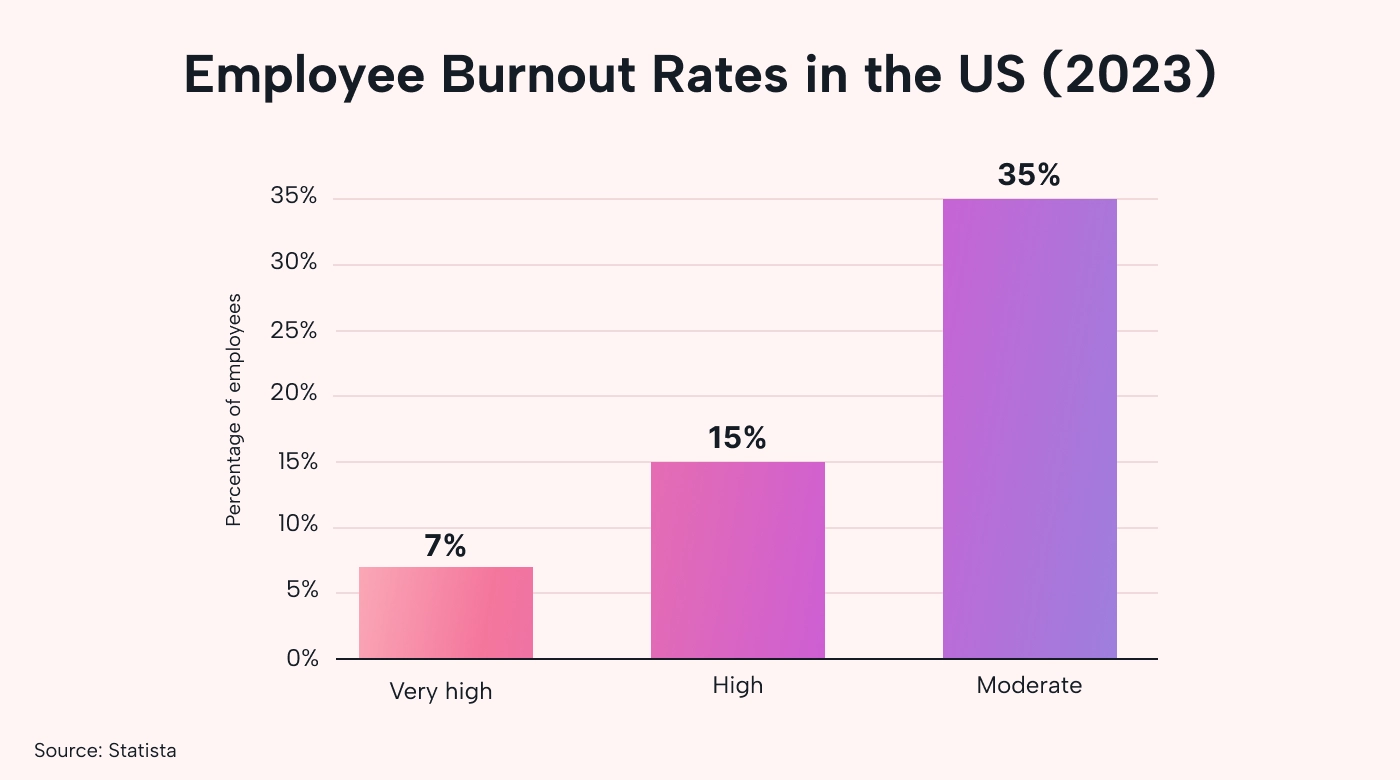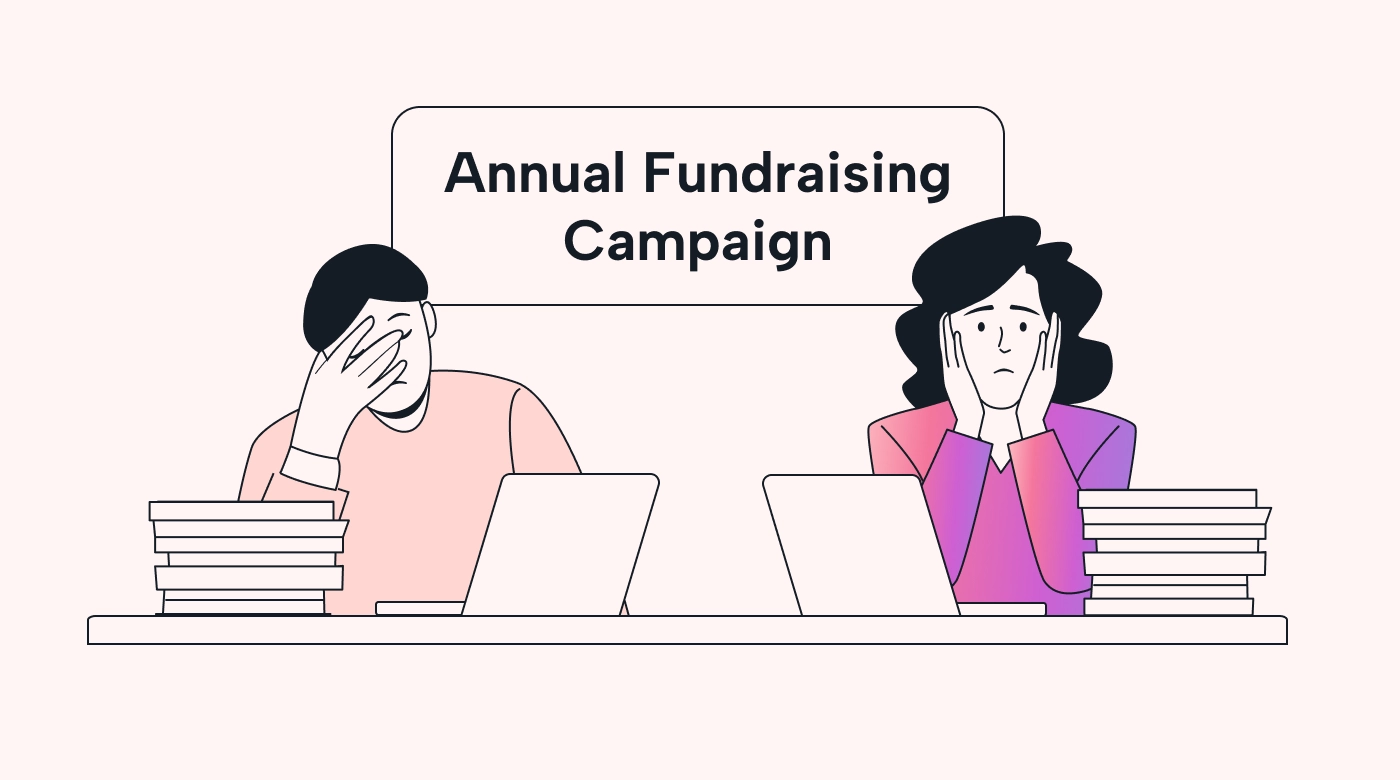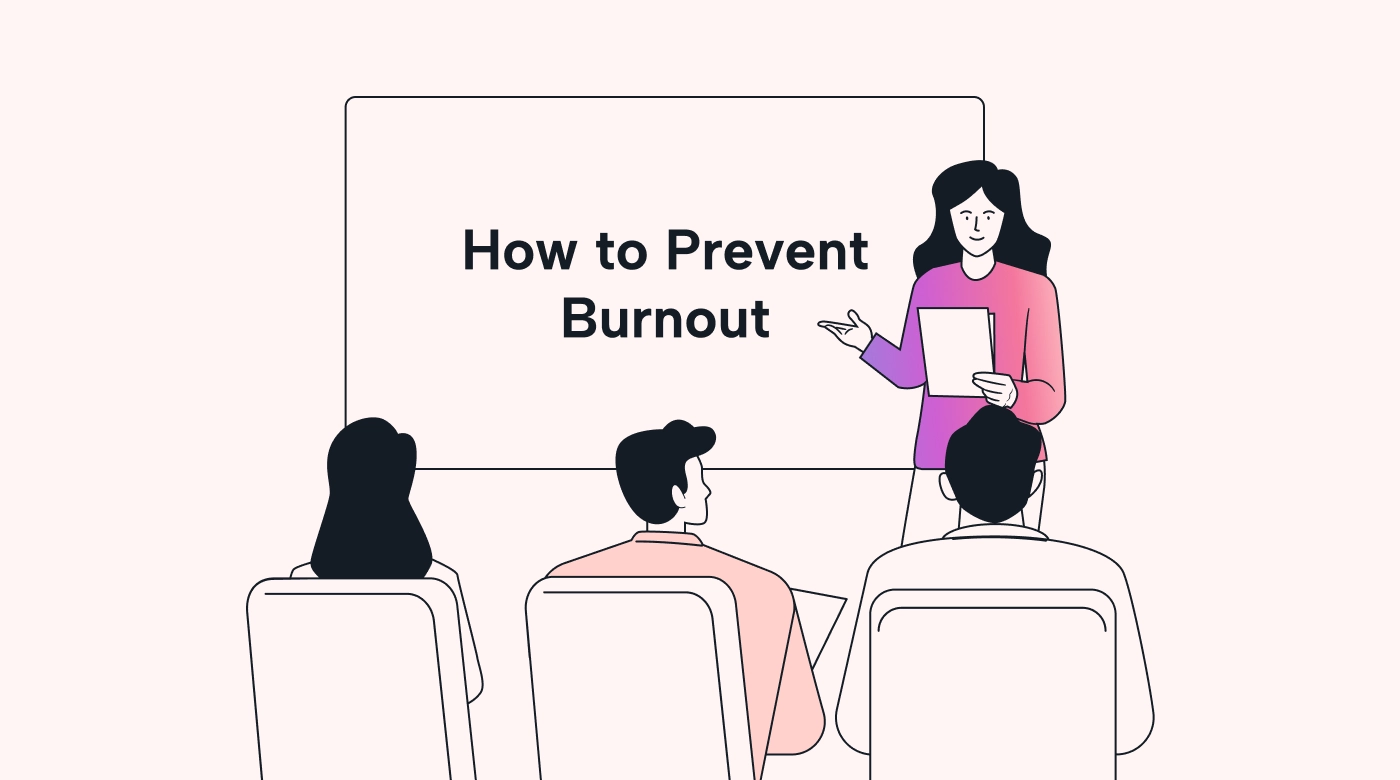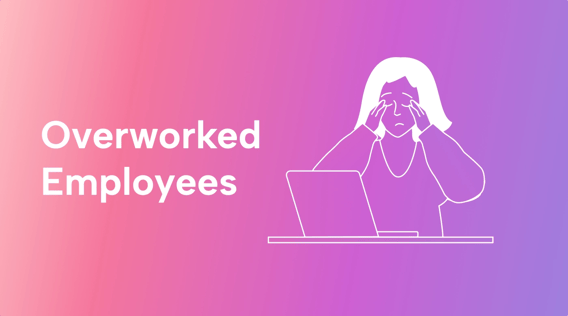The problem of overworked employees is creeping into every corner of the modern workplace.
It's not just about long hours anymore — it’s increasingly about the toll the blurred lines between employees’ jobs and personal lives are taking on their health and happiness.
When your workforce is stretched too thin, the quality of work suffers — and this can hit your company's performance hard. Recognizing and tackling this growing issue head-on is critical for the success of your business.
In this article, we take a detailed look at signs of overworked employees. You’ll gain valuable insights into the causes and effects, as well as practical strategies for solving this problem and creating a healthier, more productive work environment.
What causes overwork?
Overwork and burnout are common these days. Of all U.S. employees, 35% report a moderate level of burnout, 15% a high level, and 7% a very high level. Together, that’s a whopping 57% of the U.S. workforce experiencing at least some burnout symptoms.
 |
The typical causes of overworking employees can be grouped into five main categories:
Increased workload demand
The most widespread cause of overwork is giving employees too much work for the time they have available to focus on it. When employees are given more responsibilities without corresponding increases in resources or time, symptoms of overwork often result.
Examples: An already maxed-out supervisor is given one more person to manage, or an employee who’s still finishing up two projects is confronted with a third one that they need to start right now.
Cultural expectations
Many workplaces value long hours, period. Long hours, commitment, and productivity are pervasive cultural expectations. The subtle implication is that to climb the career ladder, you need to be one of the first employees to clock in and one of the last to clock out.
This mindset sets a precarious standard that says that your value as an employee is measured by the time spent at your desk rather than the quality of work you deliver. As such, it can unintentionally drive employees to burnout due to them simply trying to live up to this expectation.
Example: An employee who burns the midnight oil gets extra praise, even if the person’s actual output is the same as that of their colleagues.
Inadequate staffing
In many organizations, teams are shrinking, but the workload isn't. This gap forces a handful of employees to juggle multiple roles — often without additional compensation or recognition.
Example: A small IT department is expected to manage an ever-expanding digital infrastructure with no increase in headcount. This strains the staff and affects the quality of their work since they’re spread too thin.
Personal ambitions and fear
Overwork isn’t always employer-driven. Employees can also push themselves over the limit by trying to meet unrealistic personal goals or out of fear of falling behind and losing their jobs.
Examples: A young lawyer hopes to become a partner at a prestigious firm. She endures many sleepless nights and weekend work and sacrifices personal time for career advancement.
Or a seasoned employee stays late to remain visible and viable in a cutthroat environment, where the experience that comes with age is no longer considered an advantage.
In cases like these, the affected employees may not realize they are unnecessarily harming themselves and may need intervention by their manager or the HR department to set healthy boundaries.
Too much technological connectivity
Smartphones, tablets, and laptops can be to blame for overworking employees simply due to the expanded connectivity that makes employees more reachable by their supervisors after hours.
Always being connected means that work can follow you everywhere, from your child’s soccer game to the dinner table. This constant connectivity blurs the lines between work and personal life to the point where "switching off" seems like a relic of the past.
Example: An employee receives after-hours emails from their boss. This isn’t just an inconvenience but also a clear signal that their workday never truly ends. As the pressure to be perpetually available and responsive becomes the norm, they become overworked simply by always being “on.”
 |
How is overwork distributed across a company?
As you search for solutions for overworked employees, it’s important to consider that overwork doesn’t typically occur at a uniform level across an entire company.
It can crop up in unexpected places where everything appears just fine. It can affect employees you had thought were immune to burnout. It can even emerge periodically in certain areas and dive back below the surface before you realize you have a problem on your hands.
Here’s what to be on the lookout for:
Typical “hot pockets” of overwork
Overwork tends to concentrate in hot pockets of more than ordinary work stress.
For instance, for project-based teams, high-pressure deadlines can lead to temporary overwork.
In operational roles, on the other hand, the stress of continuous demands without adequate resources can cause chronic overwork situations that take time to become fully visible.
Managers and executives can become overworked due to the stress of strategic planning, decision-making responsibilities, always having to deliver great results, and the pressures of leading by example that leave them feeling like they can never make a mistake. No wonder that more than 50% of managers report feeling burned out.
Factors that contribute to uneven workload distribution
The uneven distribution of workloads across a business can often be traced back to a few key factors.
Skill shortages in specialized areas mean that a few experts may be overwhelmed with tasks while others are underutilized.
Seasonal demand spikes like retail rushes during holidays can create temporary but intense periods of overwork for some teams.
Additionally, certain departments can suffer from outdated or inefficient work processes or management practices, which can lead to bottlenecks and excessive pressure on specific groups of employees.
 |
How do you recognize overworked employees?
Overworked employees exhibit telltale signs that give away they’re not performing at their best. Here’s what to watch for:
Overworked managers
The early warning signs in managers may include a noticeable dip in their productivity and the quality of their work. What once was meticulous and timely now becomes riddled with errors or gets chronically delayed.
Alongside these professional indicators, you may begin to see personal changes. A supervisor’s mood or behavior might shift dramatically. Someone who was once upbeat and supportive, for instance, may become irritable, gruff, or withdrawn.
Physical signs are also telling. Increased stress or fatigue can lead to visible changes, such as dark under-eye circles, weight fluctuations, or a general look of fatigue and mental exhaustion.
Overworked teams and individual employees
Teams and individual employees face unique challenges as well. Often, these first manifest as missed deadlines that were once comfortably met. Such slip-ups may be a red flag for unmanageable workloads.
Increased absenteeism or lateness can also signify that employees are struggling to cope with their workloads and need a break from the mounting pressure. A side effect of these absences to look for is lower morale and less cohesion in a once well-synced team.
 |
As stress levels rise, communication often suffers, as well. These breakdowns impact the immediate tasks at hand. Even worse, they can erode the foundational trust and support within the team — which can make bouncing back from setbacks and successfully launching new projects that much harder.
HR should watch for these signs in employees and managers to catch — and resolve — overwork problems early on.
The effects of overwork
Overwork has significant effects on employees, the quality of the work they perform, and the company as a whole. Let’s look at each of these in detail:
The effects of overwork on individual employees
Overwork and burnout are often accompanied by emotional exhaustion, resentment toward one's job, and a reduced sense of accomplishment. The joy and fulfillment employees once found in their work can give way to a sense of dread and apathy.
Overwork can seriously impact employees' health, too. Prolonged stress and lack of rest can lead to chronic conditions such as high blood pressure and heart disease, as well as mental health issues such as anxiety and depression.
The impact of overwork on productivity
The quality of work inevitably suffers under the strain of overwork. Fatigue and stress increase the number of mistakes and redos, which can create a vicious cycle of even more hours to correct.
The caliber of work declines as a whole since employees can’t maintain their usual standard of excellence under such conditions. Plus, exhaustion snuffs out the creative spark that drives innovation. This leaves teams no choice but to default to routine rather than pioneering new solutions or improvements.
The consequences of overworked employees for a company
The ripple effects of overwork often manifest as high turnover rates as employees leave for companies that offer a better work-life balance. This turnover is costly — and not just in terms of recruitment and training expenses but also lost productivity and institutional knowledge.
As stress-related illnesses take their toll, the healthcare costs associated with overworked employees can also escalate.
 |
But perhaps most damaging in the long term is the impact on the company’s reputation. A culture of overwork can deter potential talent and paint the company as one that doesn't value its employees' well-being.
How to prevent overwork: 8 strategies for employers and managers
It takes deliberate action to reduce the effects of overwork on a company’s workforce. Try the following eight strategies:
1. Set realistic goals and expectations
Employers should work closely with managers and team leaders to establish realistic outputs without setting the bar impossibly high. This involves regular reviews of project timelines and deliverables so they match the team's capacity without relying on overtime as a standard practice.
2. Promote a culture of balance
Provide a supportive atmosphere where employees and managers can comfortably report feelings of being overworked to their supervisors or HR — with the knowledge that their concerns will be taken seriously and addressed.
3. Implement flexible work arrangements
Allowing employees more control over their work schedules and locations can significantly reduce their stress levels since it gives them more leeway to manage their personal commitments alongside their work obligations.
4. Invest in time management technology
Modern technology can also help to reduce overwork woes. Smart project management tools, like Motion's AI-driven Intelligent Calendar and Project Manager software, can better organize tasks and reduce unnecessary heavy workloads.
5. Train your workforce in overwork and burnout prevention
Training in this area can make a big difference in avoiding overwork problems. It consists of three basic components:
- Training HR in recognizing employee burnout issues and handling them compassionately and effectively.
- Training your managers and supervisors in recognizing signs of overload and burnout and proactively addressing them with the affected employees.
- Training and encouraging your employees in recognizing their limits and communicating workload issues without fear of reprisal or feeling guilty about not measuring up.
 |
6. Encourage regular breaks and time off
Make sure your employees take time to recharge, take enough breaks, and use their vacation time.
It’s also good practice to use time-tracking apps to analyze time-off patterns and identify any underlying culture of overwork at the company.
7. Monitor and adjust workloads
Perform regular check-ins to assess workloads and redistribute tasks if needed so that no one is consistently overburdened. This proactive approach helps maintain balance and keeps productivity high without sacrificing employee health.
8. Provide support resources
Finally, make sure employees are aware of the mental health resources, stress management programs, and wellness initiatives your company offers — and know how to access them.
Prevent overwork before it burdens your workforce
The phenomenon of overworked employees is not always easy to spot, but if it’s present at your company, it can have a serious negative impact on productivity and morale.
The best solution is to be proactive in identifying any categories or pockets of overworked employees at your company.
Motion can help you detect these problems early on. Plus, it can streamline your work processes as part of your overwork and burnout prevention strategy.
Try Motion for free for 7 days to find out more.

A certified content writer and SEO strategist, Carla Groenewegen writes about success principles and practices aimed at SMBs and not-for-profit organizations.




